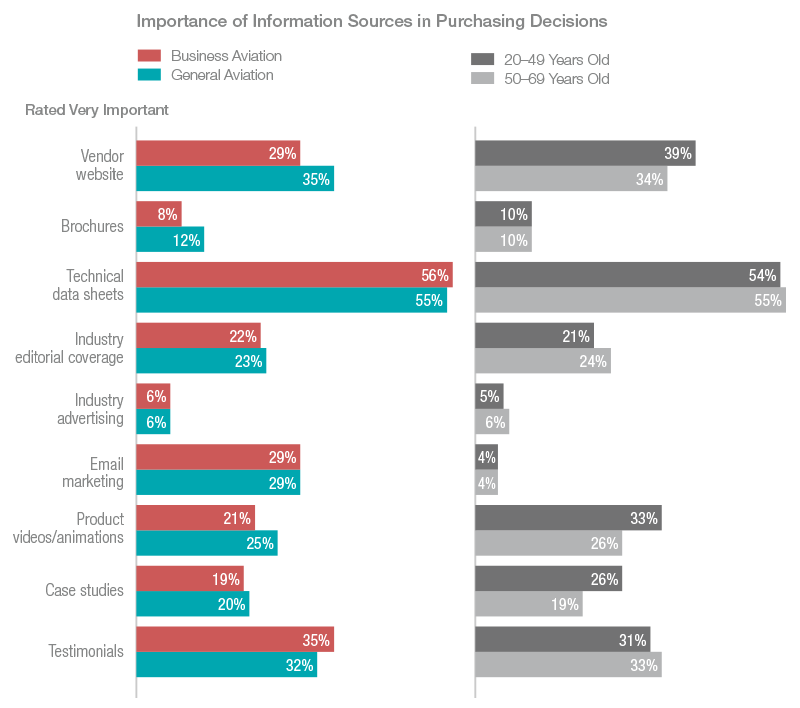Category: Aerospace Specific
7 Discouraging, Surprising, Yet Hopeful Truths About Modern Aerospace Marketing

BDN routinely uses research to understand, benchmark and report the trends and realities impacting the work we do as aerospace marketers.
In our most recent survey we asked aerospace marketers questions about their approach to budgeting and planning, goal-setting, goal accomplishment, their most effective tools and techniques, and levels of satisfaction with their company’s marketing performance.
We wondered, “Is there a correlation between those who plan and those who get results?” “Are some tactics consistently much more effective than others?” And, “Do budgets equate to higher perceived performance?”
It turns out that the answer is yes to all these questions, yet there is still much to be learned. Today we are providing a high-level summary of our findings with key takeaways and insights that shine a light (not always a flattering one) on our industry and our profession. This is ideal for those who want a quick read.
Anyone who would like more in-depth charts and findings may request the complete survey results here.
And remember, these results are suggestive, not scientific.
Key Insights & Takeaways
Finding: Regardless of their annual revenue, aerospace companies are still under-spending on marketing, with many high-revenue businesses spending just as little as their lower-revenue counterparts.
Insight: Shame on us. It’s hard to believe, but 20% of the $100,000,000 businesses have marketing budgets under $100,000. That’s an embarrassingly small .001%, and far below recommended spending and benchmarks for both B2B and our industry.
Takeaway: The budgeting process in larger companies sometimes defies logic, with decision-makers removed from the realities of individual functions. Verbatim comments tell us that more than a few companies are actually cutting marketing because industry conditions are bad. Huh? Marketers who work for an organization like this can either use data and measurement to become agents of change from within, remain ineffective, or run.
Finding: Most marketing budgets have stayed the same since 2015; a good number have increased; and very few have been cut.
Insight: Yes, this is positive news, but remember, budgets are still below accepted standards. Harvard Business Review generally suggests investing 3% of revenue in marketing, with adjustments made for specific scenarios.
Takeaway: Management probably believes marketing has everything it needs to be successful. After all, they have added or maintained existing budgets. But we can and must do better. If you are working with a limited budget, stop defaulting to old school tactics that can’t be measured — and when management wants you to do the same old, same old, explain that you can’t afford anything that fails to deliver ROI. Position yourself as the expert and start showing results to upper management that will justify the higher budget you know you need.
Finding: The majority of respondents say they do have and follow a marketing strategy and plan, yet there are striking differences here based on company revenue. More than 90% of the largest companies have a plan; less than 50% of the smallest do.
Insight: The survey shows that those with a strategy and plan are more satisfied with their company’s marketing performance than those without. It also shows that, as spending levels rise, so do levels of satisfaction with overall marketing performance.
Takeaway: A strategy, plan, adequate budget and measurement are the keys to your marketing success, regardless of company size. But if you are working with a smaller budget, strategy and planning become even more critical to ensure that every dollar spent is associated with an expected, measurable outcome.
Finding: Most respondents reported success in accomplishing key objectives. Improved brand awareness, improved customer engagement/relationships and increased sales were most frequently cited. Interestingly, 12% of those spending less than $100,000 report that they accomplished none of their objectives last year – no one spending $1 million or more said they accomplished nothing.
Insight: Regardless of budget, brand awareness and leads were cited as top successes. Because brand awareness is more difficult to measure it may be a more comfortable “metric” for some marketers. Challenge yourself to achieve more measurable objectives moving forward.
Takeaway: People are reporting success, and that’s good. Let’s just make sure those claims of success are based on data you can defend.
Finding: The most effective digital marketing efforts were websites (83%) and email marketing (79%). The highest marks for ineffective tactics were social media, blogs and online display ads, yet plenty of marketers also found them effective.
Insight: One, people are divided about what works in the digital realm. Also, while websites are recognized as effective, less than 50% say their SEO is effective.
Takeaway: We think the sheer volume of new and changing tools and options overwhelms many marketers. The first step to using the right digital tactics is understanding them – make time to get smart and use data to determine what is and is not working.
Finding: The most effective traditional marketing efforts were events and print advertising, yet print advertising also was most frequently called out as ineffective.
Insight: We continue to rely on old school tactics, perhaps to appease older, old school management, that are less likely to be measured.
Takeaway: If you are using events and print advertising (often the most expensive tactics) make sure you are tracking results. There are tools and techniques that make it possible to know if these approaches are working.
Finding: In 2016, marketers overwhelmingly say their No. 1 objective is increasing sales, followed by improved customer engagement, increased leads and improved brand awareness. Also, their No. 1 challenge is acquiring new customers, followed by lead generation and measuring ROI.
Insight: Hurray! Marketing exists to drive sales, and we are heartened to see folks acknowledging this connection.
Takeaway: Take a look at the relationship between marketing and sales in your organization. Are you using a CRM and marketing automation system to facilitate tracking, measurement and accountability? Are you working harmoniously toward a common goal? Or is there friction and finger pointing? Make mending and strengthening these relationships — adding in accountability for everyone — a priority for the good of the business.
Next up:
Keep reading next week for verbatim comments from more than 30 respondents who wrote to us about the challenges, opportunities and trends they are experiencing in their aerospace marketing work.
Don’t forget:
If you liked this blog post, you may also be interested in these free BDN resources:
- How to Develop a Marketing Communications Budget
- Budget Planning Checklist
- Marketing Planner
- 30 Days to Better Digital Marketing
10 insider secrets to getting your aerospace news published
 This week we are pleased to bring you a guest blog written by Jeremy Parkin, publisher of HeliHub.com. Jeremy has generously provided us with highly specific, actionable advice about what journalists do and not want from aerospace marketers in their PR outreach efforts, and his guidance is spot on. Read and follow these 10 tips and your media profile will improve — guaranteed.
This week we are pleased to bring you a guest blog written by Jeremy Parkin, publisher of HeliHub.com. Jeremy has generously provided us with highly specific, actionable advice about what journalists do and not want from aerospace marketers in their PR outreach efforts, and his guidance is spot on. Read and follow these 10 tips and your media profile will improve — guaranteed.
Editors are busy people, but you want your news item to get read and used. The more your stories, images and videos can be seen, the more your organisational profile will rise and be recognized compared to your competitors. Journalists could be out of their office, so these tips will help you reach people who may work for extended periods of time off a smart phone or tablet.
A key part of the process is to present the information in the most accessible way, and from my experience launching and building the world’s first helicopter industry news website, I hope these tips will guide you to better success in promoting your news. I also have a significant background in the IT industry, particularly social media, and I hope these insights assist in that arena, too.
- Document formats The text of your press release needs to be easily accessible by an editor. You want them to cut and paste quotes from your key people. We are much less likely to use a PDF press release and will prioritize a Word document. Better still, put the text of your press release in the body of an email like Airbus Helicopters does. Avoid sending press releases as attachments, and don’t send multiple languages of the same text in the same email – our automatic translation software gets very confused when Turbomeca (now Safran) send English and French in the body of the same email message. These rules apply irrespective of whether you send emails direct, or use an email marketing system such as MailChimp.
- Multiple stories If you are sending two stories, send them as separate emails, ideally a week or more apart, and ensure they are distinctly different. A few years back, Bell Helicopter took to issuing a new press release for every single country that approved a higher MTOW for the 429 model, in some cases countries where they needed lots of optimism to even sell an aircraft. That soon became a “Boy Who Cried Wolf” situation and we exercised the [Del] button.
- How many images? Every press release needs an image – the saying, “A picture is worth 1,000 words” still holds true. Some say multiple images mean bigger (and slower) emails which could be quarantined by an email server, so consider supplying images via a link to a public-access folder on Dropbox.com like MD Helicopters do.
- Image File Format As HeliHub.com is entirely online, we prefer JPG. Media outlets that encumber themselves with hard copy issues may prefer PNG but will still be able to handle JPG. Images embedded into a PDF are ignored as too difficult to extract, even if it is technically possible.
- Image Size To present your image at a quality level which can be used, the minimum dimension should be 2000 pixels. With many smartphones capable of taking images or 3-4000 pixels, there is no excuse. Over half the images we receive are 1000 pixels across or less, and we ignore them. Be careful using a wire service. as some of them restrict image size and force the reader to sign up to something to get full-size images — the chances they will sign up are low.
- Presenting the subject in an Image Flying means wings or rotor blades, and these make for landscape images (wider than height). But the editor may have a portrait (taller than width) gap to fill. Leave “editing space” around the subject. At HeliHub.com we post two news-related images to Instagram every weekday, and that usually means square images. We also change our Twitter header image weekly – and that needs an image three times wider than its height.
- Lighting and weather We ignore dreary photos unless the subject is really important. Improve your images using free software such as GIMP. Very recently the image of the third AW609 tiltrotor prototype needed editing time as it looked like it was taken in a rainstorm.
- Corporate image bank Sometimes an editor will prefer to use your corporate logo, and you should have these available on (or from) your website, along with head shots of key people in your organisation. Consider using a free service like OpenBrand.com to host these, like Helipaddy does.
- Video format/location Press release video is still rare, but the click-through to a video online is remarkably high, so the cost may be worth the effort, even if the video is less than 60 seconds long. Minimum format is HD these days, and some in 4K. Only a few aviation organisations are using 360-degree videos, but this will be the way ahead for aircraft interiors or to show details of an equipment installation. Do not save videos on your own website, but instead on YouTube, Vimeo or Wistia so they can then be embedded easily into a story online. The vicarious benefit is the extra views from the search traffic of those sites – remember, YouTube is the world’s second biggest search engine.
- Compressed file formats Do not submit ZIP files; they are too much hassle. People who ZIP a JPG file are demonstrating that they don’t know that JPG format is already a compressed file format.
Interested in more information about working with the aerospace and defense news media? BDN has compiled a complete PR toolkit full of tools and tips to improve your skills and your results. Tons of other free aerospace marketing resources are also available for download. View the entire library here.
How to market and sell to GA and BA audiences
This final installment in our series on purchasing behavior in General Aviation (GA) and Business Aviation (BA) seeks to better understand the marketing tactics that are likely to be most effective with these audiences.
We asked respondents to rate the importance of various information sources they may reference during the decision-making process and were surprised to learn that technical data sheets are strongly favored, regardless of age or market segment. Fifty-six percent of respondents consider data sheets very important, and an additional 35% see them as moderately important — that’s 91% of respondents.
Regardless of age or market, respondents also value testimonials, vendor websites and product video/animations, but industry advertising ranks dead last with all groups surveyed.
How much of your marketing budget is devoted to advertising or brochures? If you are spending a significant amount on these items it might be time to reconsider and reallocate to other resources that buyers find more important.
Who, among human information sources is least valued? Sales reps. Only 9% on average consider sales reps very important. In-person demos or other direct experience rates the highest, followed closely by industry contacts and friends. Distributors or dealers and trade shows fare only slightly better than sales reps. We were most surprised by the rather mediocre performance of trade shows, especially with the BA respondents, who also place greater value on their industry contacts and friends than do the GA respondents.

It turns out that no one, regardless of age or market segment, wants to be sold, either by sales reps, or dealers, or at trade shows. This tells us that an inbound marketing approach, where businesses draw customers to them by providing helpful content (and not sales pitches), could have great utility and value for aviation marketers.
We also asked respondents what resources they refer to during their consideration and evaluation process prior to making a purchase. All respondents prefer to speak with trusted colleagues over Google searches and referencing company websites. BA respondents place more value on their existing knowledge, while print and digital magazines rank last with everyone.
But when you whittle down those choices and ask respondents to pick just one resource, speaking with trusted colleagues is picked 43% of the time, followed by a big drop to 14% using Google, then about a 50% drop to the other “top” choices such as website, existing knowledge and magazines.
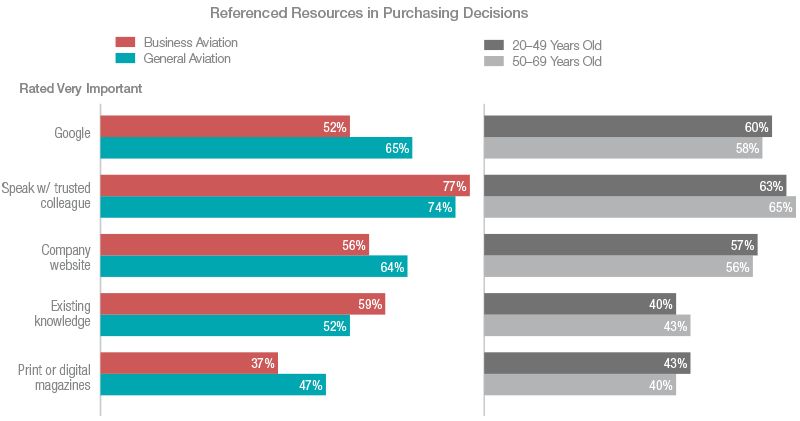
As we keep seeing throughout this series, people trust their own experiences and the opinions of friends and colleagues; performance is king; brands are not important; and no one wants to be sold.
For marketers, the keys to the kingdom are in finding ways to allow more people to use the product/service and then turn those users into unpaid evangelists. Work hard to make non-sales-y, factual and data-driven information available via multiple channels, including the web. And look carefully at the investment being made in trade shows, brochures and advertising. You may find it wise to re-allocate some of those funds to product demos, content marketing or referral programs.
To learn more about buying behavior in GA and BA, reference the other blogs in this series here and here. To subscribe to this blog and enjoy weekly email delivery, click here.
To approach your marketing in a more strategic fashion, download this easy-to-use marketing planner. It’s one of the most popular resources we offer.
Decision-making factors in the aviation buying process
The May 10 Flight Manual focused on understanding the characteristics of purchasing decision makers within the business aviation (BA) and general aviation (GA) markets.
This week we dig deeper still to gain insight into the product and supplier factors that most influence their buying decisions. This goes to the heart of what buyers value most, so it’s directly relevant to those who market and sell to these audiences.
Looking at responses by both age and market we learned that, with a few exceptions, buyers tend to value the same things regardless of age or segment.
This is a somewhat high-level generalization, and we will highlight points of difference, but there are clear trends and preferences that apply across the board. It’s clear that people in these markets are more similar than they are different. Let’s take a closer look.
We asked respondents to rank the importance of various product and service criteria in their purchasing decision-making process. These criteria included price, perceived value, quality/reliability, operating costs, safety, turn/delivery times, and potential performance or efficiency improvements.
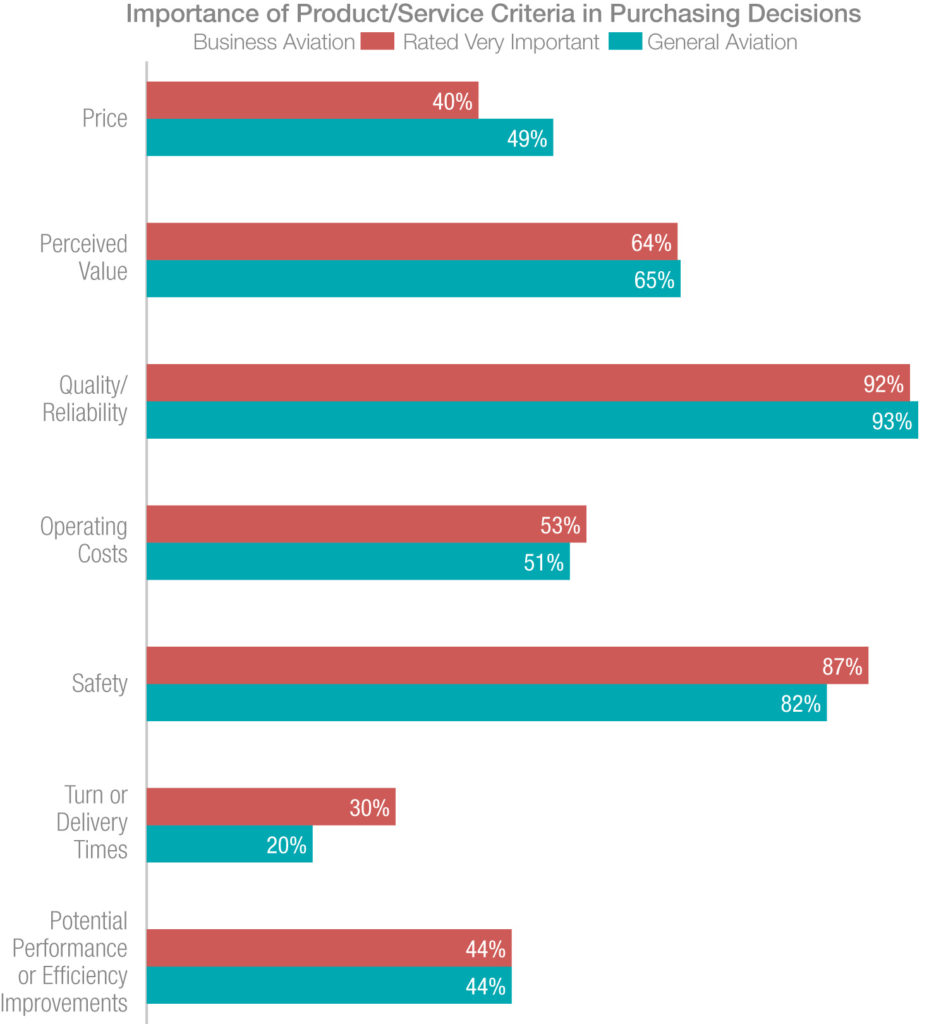
Both market segments are most concerned with quality and reliability, closely followed by safety, which was even more important to business aviation respondents.
While price is more important to GA, it is not the most important factor. In fact, it is similar in importance to efficiency improvements, and both are trailed by turn/delivery times, which matter more to BA than GA.
Moving on to look at the responses by age, we see that older and younger respondents generally value the same things.

Again, quality/reliability is first (and valued even more by older audiences) and safety is a close second. Perceived value is third, followed by operating costs and then price, which ranks much lower in importance overall. Potential efficiency improvements trail closely behind price, and turn/delivery times rank last, though they are slightly more important to older respondents.
Overall, people want the product to keep working, operate safely, represent a good value, and without costing a lot to operate — if they have to wait to get all of this, they will wait.
Based on this information, marketers should work to quantify and communicate the quality, reliability, safety and operating cost advantages of their products relative to their competition. Don’t make broad claims – use credible data and be specific to establish a clear competitive edge while shaping an overall perception of value.
When considering supplier-related factors such as product features, product benefits, vendor brand/reputation and customer service/support, it’s again evident that there are few differences between BA and GA.
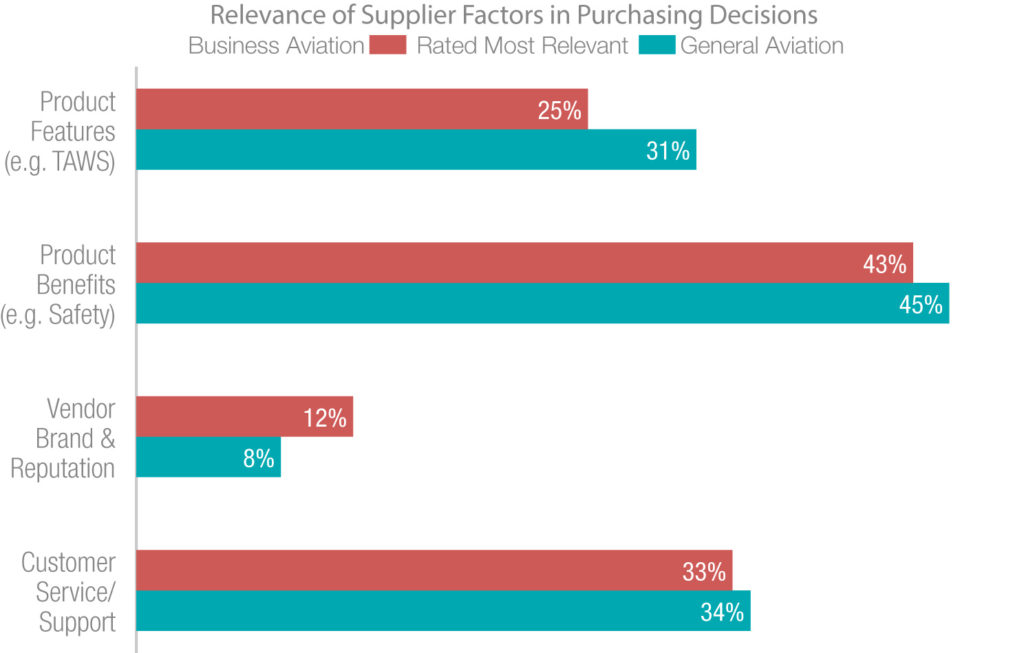
Product benefits, such as safety, rule as most relevant to purchasing decisions, followed by customer service and support.
Ironically, we see that many aviation marketers focus heavily on product features and company-centric messages — yet these are much less important to their buyers.
These results tell us that aviation marketers who focus on what their customers really care about, and do it in a way that clearly and credibly distinguishes them from other providers, will win every time.
Looking at respondents by age, product benefits are still of top importance, and are even more important to younger buyers. Everyone values product features next, followed by customer service/support (which is substantially more important to those over 50).
Vendor brand/reputation ranks dead last, once again validating that buyers are benefit-oriented.
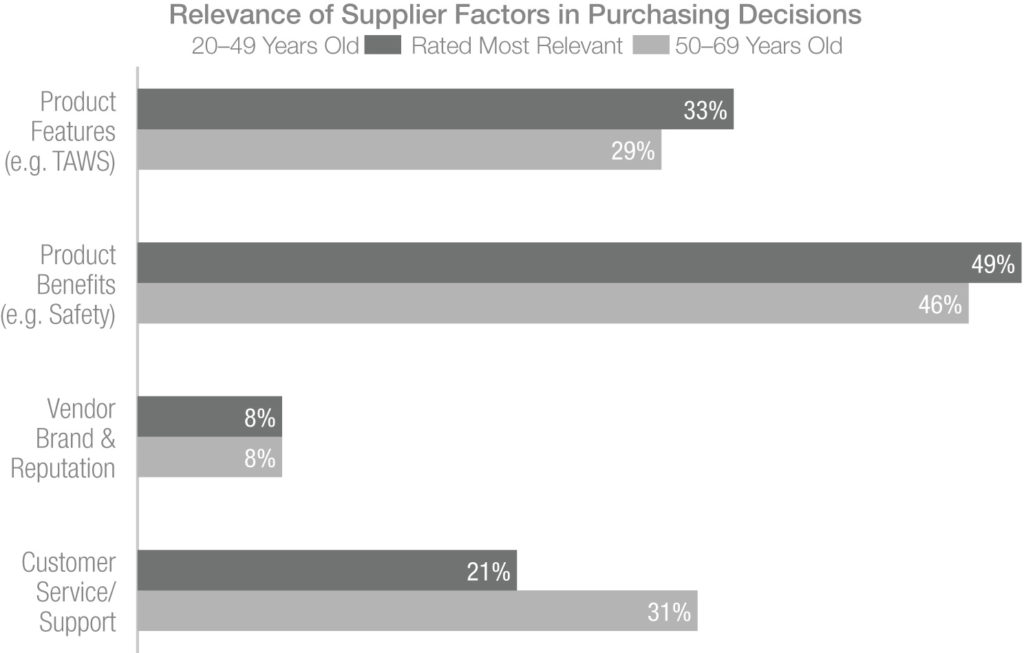
One could argue that a good brand is a shortcut to many of the features and factors that are preferred by respondents, but if we take them at their word, this survey sends a clear message to marketers about how to fine tune their marketing objectives, investments and messages for maximum effectiveness.
Coming up next week – from websites and data sheets to sales reps and dealers — find out what information sources are most influential in the purchasing process — and how those sources vary by market and age.
To further improve and approach your marketing in a more strategic fashion, download this easy-to-use marketing planner. It’s one of the most popular resources we offer.
Purchasing Behavior in GA & BA Part One: Demographics
Working in conjunction with AVweb, BDN Aerospace Marketing recently surveyed 2,500+ general and business aviation professionals to better understand who they are, and how and why they make purchasing decisions.
Respondents ranged from self-described line pilots and private pilots to directors of maintenance and CEOs. All are involved in aviation, working in businesses ranging from real estate and security to agriculture, mining, software, architecture, construction and much more. It’s a diverse and interesting group that largely self identifies as purchasing decision makers. If you market to these individuals, this high-level overview should be helpful, and more details are available on request.
Today our focus is defining and understanding this group of respondents, and we will start by saying this: they are old. In fact, older than we expected, and as marketers, we must be keenly aware of this finding.
We already know that the GA and BA communities are aging. The Aircraft Owners and Operators Association (AOPA) reports that between 1990 and 2010, the average age of U.S. pilots, for example, increased from 40.5 to 44.2, and that number continues to rise, “posing serious challenges for the industry.” Our respondents, who represent more than just pilots, were older still. Those in business aviation are notably younger than those in general aviation, but still aging. Less than 20 percent of the BA respondents are under 50 and that number drops to less than 10 percent for GA.

In the group surveyed, the vast majority of respondents were 50 or older, but that doesn’t mean we can ignore the under-50s. These younger people do play a role as influencers and decision-makers, and we need to understand and market to them now, preparing for the time when they represent the majority.
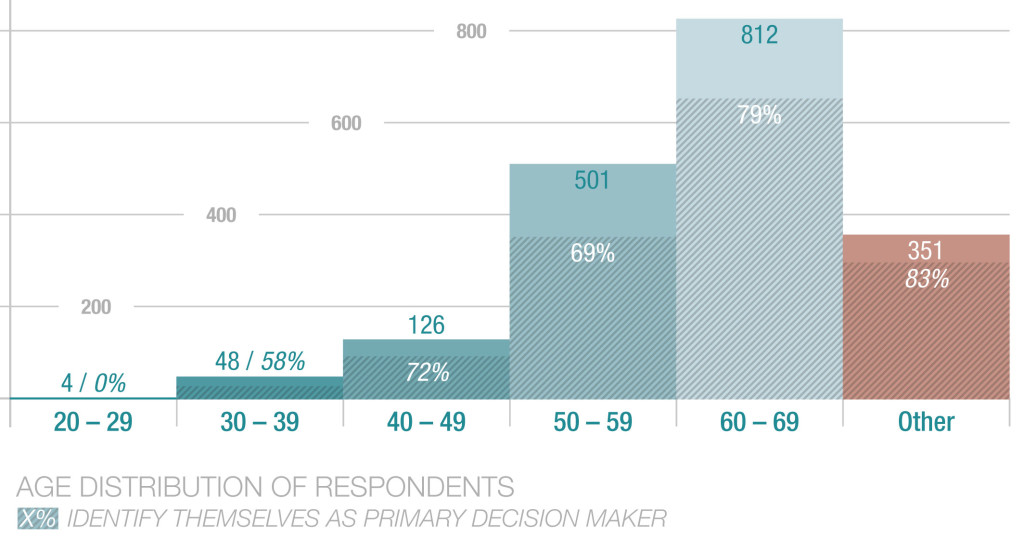
Older respondents in GA are much more likely to be part of an organization with an individual decision maker and to describe themselves as a primary decision maker.
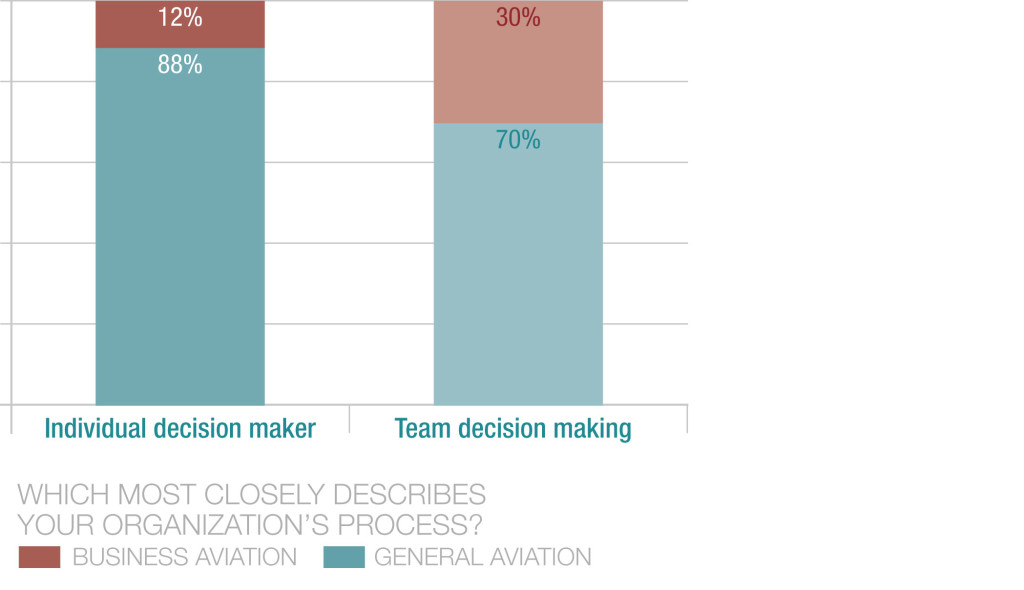
While there is much more team decision making within the BA segment, about half of these respondents say they make the final decisions. Further analysis showed that younger respondents are more likely to describe themselves as influencers in an organization where team decision-making is the norm.

Based on all of these findings, marketers looking for quicker sales in either segment may want to focus on older prospects who are generally better off financially and are also in a position to make individual decisions without team or committee consultation.
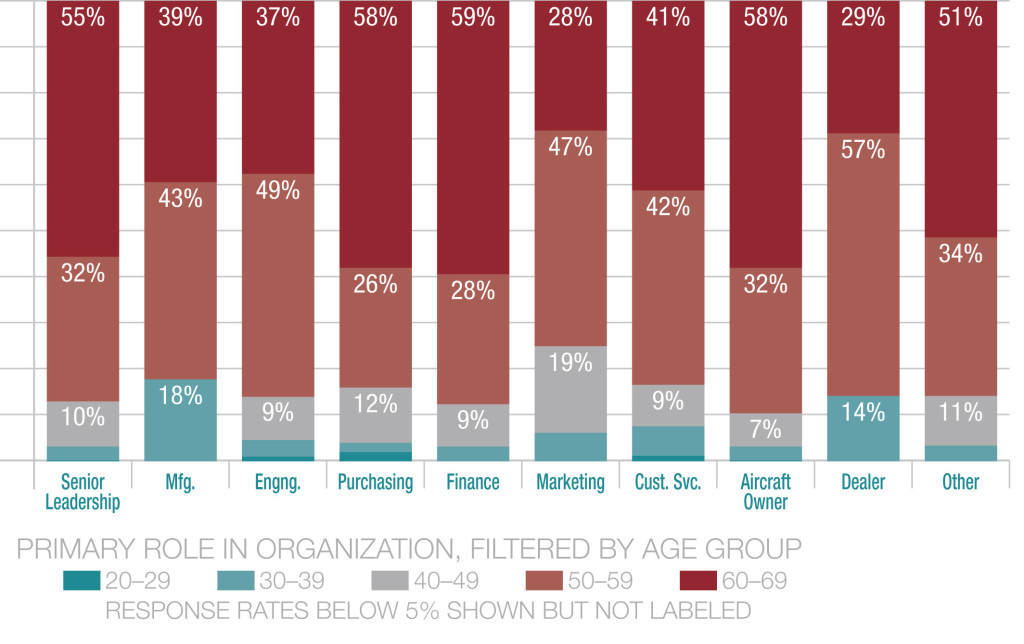
Younger respondents (those under 50) tend to have a larger presence in functions such as manufacturing, marketing and with dealers. Fifty-somethings are strong in engineering, marketing and with dealers. And the oldest respondents dominate senior leadership, finance, purchasing and procurement and aircraft ownership.

Not surprisingly, aircraft owners and operators dominate GA while there are a significant number of self-described senior leaders in BA. Once again, the older prospects are likely to be the most attractive targets for marketers, depending on what is being sold.
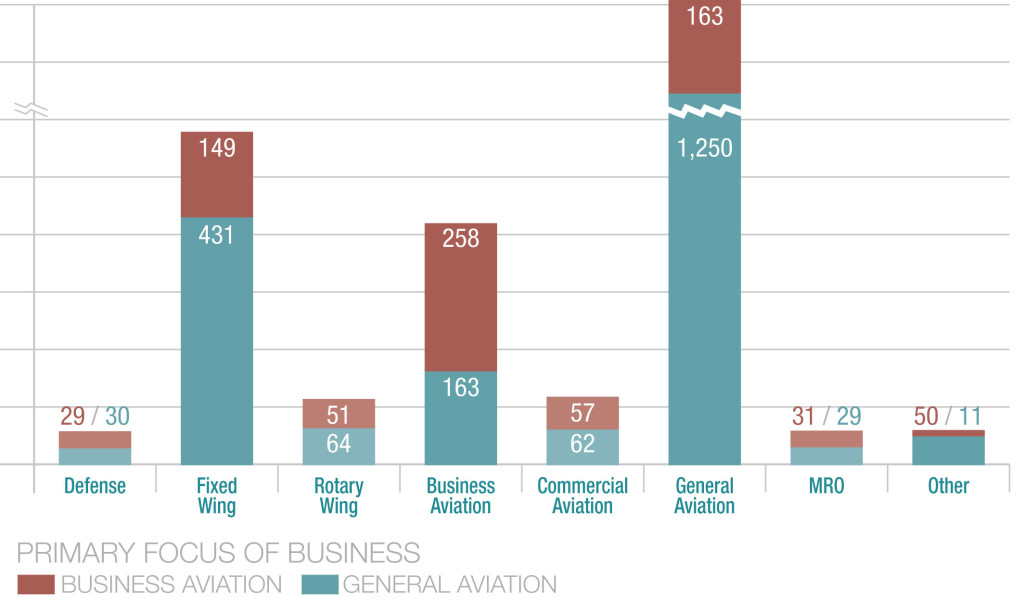
Survey findings are most reflective of respondents with a focus on fixed wing businesses in the GA and BA segments, but rotary wing and commercial aviation were relatively well represented. If you market to these groups, this information should prove valuable.
Coming up next week: See what respondents value most in products, in services, and in suppliers (hint: it’s not brand or reputation) and see how priorities change based on age and market segment.
To further improve and approach your marketing in a more strategic fashion, download this easy-to-use marketing planner. It’s one of the most popular resources we offer.
7 Research Questions that Can Change Your Marketing Forever
BDN believes in research both for the industry and for our clients. And you should, too.
Please don’t discount research because you think you understand your audience. No one in our field can afford to base marketing decisions and investments on guesswork or assumptions about audience definition, needs and preferences. You have to know.
This Forbes article, “Why Knowing Your Audience is the Key to Success,” advises that “a solid market research campaign plays an important role in a successful marketing initiative by giving you the information you need to focus in on your audience and content.” And that’s really the point — gathering the right information to make your marketing more effective.

However, research is a complex topic that should not be approached lightly. If you’re thinking about conducting research of your own, it’s important to ask the right questions. Whether you are doing one-on-one interviews, focus groups, or an online written survey, here are 7 types of questions you’ll want to include in your research initiative.
- Who, specifically, are the decision makers for purchasing your products/services? Procurement people? Pilots? Maintenance personnel? Others? Prioritize them, separating by market segment if needed.
- What role do they play in purchasing decisions? Are they influencers? Sole decision-makers? Part of a committee or team?
- How do your targets make decisions? What factors are most important to them? Do they value price above all else? Strive to understand everything you can about their decision-making process and tailor your marketing to match.
- What are the demographics of your audience? Consider asking about gender, age, and geographic location, for example. Cross-tabulating this information with other findings can provide valuable insight.
- What does the audience know or believe about your company and products versus competitive offerings? Are they aware of your business and product line? Do they have a positive impression? Understanding awareness and perceptions will fundamentally shape your campaign strategy and tactics.
- What are the pain points, problems and challenges they face? For example, if they are challenged by unreliable products — and if reliability drives their decision-making — you have gained a valuable leverage point that can set you apart from the competition. Also, consider including an option for respondents to write in comments. These can be incredibly helpful.
- Where and how do they learn about products and services that may be of interest to them? From Google to advertising, print collateral to dealers, learning what channels are most influential can guide how and where you invest limited marketing budgets.
Want to learn more? Don’t miss this in-depth piece from B2B International.
And watch this space next week, when we begin presenting original research detailing how purchasing decisions are made within the general and business aviation markets.
Aerospace Advertising: What We Learned
When it comes to advertising, there’s one thing we can all agree on — things are changing.
Our month-long look at advertising was filtered through the lens of aerospace marketing professionals who shared their thoughts, experiences and insightful comments.
There were no true eureka moments — some findings were predictable and many a bit surprising — but we did learn a lot and uncovered several valuable takeaways.

While the survey shows that print is still important, the comments add some revealing caveats. Some marketers support print but characterize it as somewhat of a “necessary evil,” acknowledging that it is “unaccountable, expensive and slow,” yet driven by the belief that it is still necessary to reach older decision-makers.
Digital is valued because it is “trackable, targeted, and interactive,” and we are encouraged that marketers value measurement. Respondents are increasing their digital spending and most agree that digital advertising will ultimately displace print. The only real question is when it will happen. The cost difference between print and digital was mentioned quite frequently — BDN predicts that gap will close. As digital demand increases, prices will, too.
The comments make it clear that for the time being, print and digital are both important. As one respondent said, “an integrated strategy involving digital and traditional communications works best,” and this is a position BDN generally agrees with.
With clear goals and a smart strategy, the correct mix of tactics is generally quite clear, and for us, this is the key takeaway. Start with a sound strategy and the tactics will take care of themselves. This complete marketing plan template — customized for aerospace and defense — can help.
To see complete survey results, click here. To view marketers’ preferred publications, click here. And to read respondent comments, click here.
Don’t forget — this listing of 300+ A&D-specific media is a useful tool for advertisers. Download yours here.
Advertisers Speak Their Minds

Part three of our April focus on advertising is a recap of written comments accompanying our survey about “The Role of Advertising in Aerospace & Defense.” The majority of respondents provided written comments. An array of 20 representative remarks, some edited for space and grammar, are included here. To see what your fellow advertisers had to say, read on.
Now, if you don’t want to miss a single comment (and believe us, you don’t), you can download an expanded written summary of what 75 marketing pros really think about A&D advertising.
Meanwhile, here is a recap of how industry marketing professionals responded to our request to “please share your comments about print and digital advertising as they relate to marketing programs for aviation, aerospace and defense.”
We hope you find it as interesting and enlightening as we did.
‘Print is Dead’
“Digital is the way to go. Print is dead. It is old news before it is even published and mailed. Websites that engage the customer base and apps that provide utility with advertisements are a gold mine for us.”
“Targeting options in digital advertising offer much more bang for the buck than traditional print advertising options. I received my new AC-U-KWICK today and promptly threw it in the trash.”
“Print media has become outdated and hard to justify. Digital media is more trackable, targeted and interactive.”
“As a small company trying to displace the big boys, we have our best success with sales letters and road trips. Our limited print ads have yielded zero sales. We strongly feel that traditional print ads (blue sky, aircraft, product shots) do not help a small company break through. But we also strongly feel that a non-traditional campaign combining multiple outlets could. We believe that non-traditional print ads will be more and more effective as our prospects replace their old school vanguards with younger staff. So, we are focusing hard on how to make a non-traditional approach work.”
“Flight International, Aviation Week and other high dollar placements are getting the axe in favor of a more diverse and digital-centric strategy.”
‘A Break from the Digital Onslaught’
“Print has sustainability and is ideal for increasing image and brand awareness.”
“The current generation of decision-makers still relies on print for in-depth reading and information. Digital is fine for transitory news, but not for critical study.”
“There is too much digital advertising through social media and emails, so I ignore it. But with print I take my time and read through the entire magazine looking for information that may help my business. It provides a break from the digital onslaught.”
“Digital advertising is still not as effective as print. There are still too many old school decision makers who are not technically savvy.”
“Print is still the way to communicate to C-suite execs.”
‘We Need Both’
“In today’s market, print and digital advertising must work hand-in-hand in the marketing mix. Online presence reinforces the branding efforts through traditional print media and gives a valuable sense of immediacy to the messages.”
“An integrated strategy involving digital and traditional communications works best. The publications still have influence, and working with them benefits our company.”
“While I still focus primarily on print advertising, I usually look for a digital add-on. This could be a digital copy of the magazine with hot links to advertising, or a banner ad that is included as part of my buy.”
“Print is still a necessary evil, but digital brings much more value.”
“When your marketing challenge is establishing brand awareness, print advertising tied to measurable digital landing pages is still a good investment. For the selling of an established product or service, there are more effective channels.”
‘Editorial Still Beats Advertising’
”The industry as a whole seems focused on placements to say they were in a magazine rather than executing a real strategy.”
“Editorial, whether print or digital, still beats all advertising. Print, when distributed at high-profile industry conferences or trade shows, is effective. Ads in daily or weekly newsletters are also effective. Digital ads and digital directories are my least favorite — there is so much noise on web pages that they go unnoticed, and most of the time they are annoying.”
“For our company, it seems that when new clients find us it always start with a Google search.”
“Advertising helps promote our brand, but direct mailers and other activities engaging customer prospects are most effective in generating/closing sales.”
“Print is unaccountable, expensive, slow and perfect for the bathroom or La-Z-Boy recliner. Digital means fast feedback, video demos, click-through tracking.”
Don’t forget — this listing of 300+ A&D-specific media is a useful tool for advertisers. Download yours here.
Read Additional Insights
For a PDF document with the complete, must-read comments, click the image and don’t forget, we welcome your feedback — so tell us what you think!
People’s Choice: A&D Marketers ID Preferred Publications
 Because our industry is served by more than 300 aerospace and defense publications, a comprehensive survey determining individual preferences is simply not feasible.
Because our industry is served by more than 300 aerospace and defense publications, a comprehensive survey determining individual preferences is simply not feasible.
Instead, to identify and understand trends, we asked an open-ended question: “If you could only choose to advertise in a few industry publications (print or digital), what would they be?” By not requiring respondents to refer to a list of choices, we hoped to uncover trends in a more organic fashion.
Here’s what we learned, based on the number of write-in “votes” (shown below) for each publication, and congratulations to the top five: Aviation International News, Vertical, AOPA Pilot, Aviation Week & Space Technology, Flying, and Rotor & Wing.

So, what do you think of the list? Is it consistent with your experiences? Whatever your opinion, we’d love to hear from you in the comments section and facilitate a dialogue about the role of advertising in aviation, aerospace and defense marketing.
Next Up:
Our series on the “The Role of Advertising in Aerospace and Defense Marketing,” will continue next week as we share verbatim comments from more than 100 industry marketing professionals who took our survey. Watch for it on April 19.
Don’t Forget:
A more substantial overview of survey findings is available here. Also, if you find our blog and other resources to be useful, please share them with a friend!
We asked: Does the future of aerospace include advertising?
 Advertising — once the mainstay of BDN’s business — is now a source of ongoing discussion, debate and uncertainty within the Aerospace and Defense industry. Our team routinely fields a great many advertising-related questions from clients and colleagues. We find that in general, people want to know if advertising is relevant, effective and worth the investment — and they often want to know about industry trends and understand what their peers are or are not doing.
Advertising — once the mainstay of BDN’s business — is now a source of ongoing discussion, debate and uncertainty within the Aerospace and Defense industry. Our team routinely fields a great many advertising-related questions from clients and colleagues. We find that in general, people want to know if advertising is relevant, effective and worth the investment — and they often want to know about industry trends and understand what their peers are or are not doing.
This survey, “The Role of Advertising in Aerospace and Defense Marketing,” was designed to get a sense of trends and how advertising is used and viewed in our industry today. Based on more than 150 responses, from marketers covering a broad array of industry segments, it is not a scientific but is certainly suggestive. We hope you find it useful.
Key Finding: Advertising is in decline, and people who once advertised are no longer advertising.
While 93% of respondents said they have advertised in the past, just 72% say they advertise now.
Key Finding: In general, the majority of advertising budgets are increasing or staying the same. Fewer budgets are declining.
Key Finding: The majority of respondents think print advertising is still relevant and effective in our industry, but many are unsure.
Key Finding: While print is still important to respondents, digital is growing in importance, with spending split fairly equally between print and digital.
Next Up: Our series on the “The Role of Advertising in Aerospace and Defense Marketing,” will continue next week as we reveal industry marketers’ preferred publications. Watch for the People’s Choice results on April 12.
Don’t Forget: BDN’s Complete Guide to Aerospace & Defense Media is a great resource for industry advertisers. Download it here.

